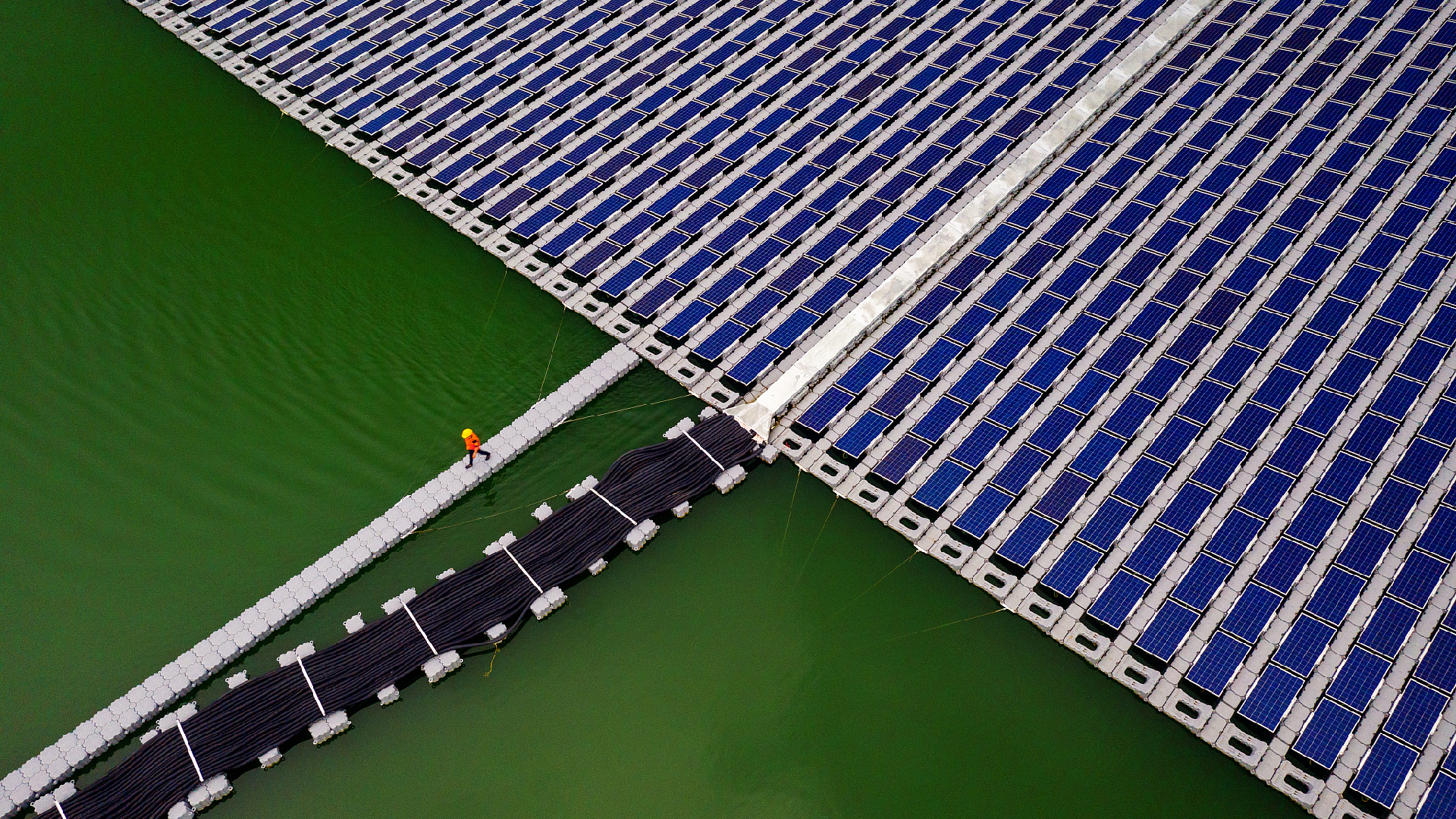Green partnership blooms: China, Vietnam drive new energy cooperation


<img src='https://news.cgtn.com/news/2024-08-18/Green-partnership-blooms-China-Vietnam-drive-new-energy-cooperation-1w9TTIoPVny/img/c9f47cd801ba4df5ae459167c0332882/c9f47cd801ba4df5ae459167c0332882.png' alt='A staff member walks across a floating solar panel farm, the Da Mi power plant, in Binh Thuan province, Vietnam. /CFP'
With the global spotlight on renewable energy, China and Vietnam – two dynamic neighboring economies in Asia – have been forging strong ties in the realm of new energy.
Recognizing the immense potential of renewable energy sources and the imperative to address climate change, the two nations have embarked on ambitious clean energy initiatives. This collaboration has led to significant advancements in wind power, solar energy and electric vehicles (EVs).
Wind power: Harnessing the force
One of the cornerstones of China-Vietnam new energy cooperation is wind power. With extensive coastlines and abundant wind resources, both countries possess ideal conditions for wind energy generation. Chinese companies, renowned for their technological prowess and cost-effective solutions, have been actively investing in Vietnam’s wind power sector.
Since late 2020, when the first Chinese wind turbine was installed in central Vietnam’s Ninh Thuan province, the presence of China’s wind power technology in Vietnam has been expanding. The country has invested in dozens of wind power projects in Vietnam, which has become the largest export destination of China’s wind turbines.
The Phu My Solar Power Plant, a 330-megawatt behemoth, stands proudly in the coastal, sandy expanse of Binh Dinh province, Vietnam. This significant project is a cornerstone of the nation’s National Power Development Plan 7, and boasts the title of the largest photovoltaic power station in central Vietnam. Its strategic location and impressive scale position it as a pivotal player in the country’s transition to a sustainable energy future.
Constructed by the Power Construction Corporation of China, the Phu My plant is more than just a power generator. Its design is a testament to forward-thinking, with a vision that extends beyond electricity production.
The project’s blueprint incorporates potential expansions into complementary energy sectors. This includes the exploration of energy storage solutions, the production of clean hydrogen and ammonia, and even the possibility of desalinating seawater using renewable energy. Such ambitious plans highlight the plant’s potential as a multi-faceted clean energy hub.
<img src='https://news.cgtn.com/news/2024-08-18/Green-partnership-blooms-China-Vietnam-drive-new-energy-cooperation-1w9TTIoPVny/img/52c07f7d14154c4492cd01ca14834ca8/52c07f7d14154c4492cd01ca14834ca8.jpeg' alt='A wind turbine built on the grounds of a cemetery at the Phu Lac wind farm in southern Vietnam's Binh Thuan province. /CFP'
Solar power: Powering the future
Solar energy is another key area of cooperation between China and Vietnam. Both countries enjoy ample sunshine, making solar power a viable and attractive option for clean energy generation. Chinese solar panel manufacturers, known for their efficiency and affordability, have established a strong presence in the Vietnamese market.
China’s solar power enterprises have been building their industry chains in Vietnam since 2014. Over a dozen companies have invested more than $2 billion to build the largest solar power industry cluster in Vietnam.
Vietnam’s electricity demand is on the rise, driven by rapid economic growth. To meet this surging energy appetite, the country is increasingly turning to its neighbors for power imports. According to Le Van Luc, deputy director of the Electricity and Renewable Energy Authority, annual electricity imports from China and Laos are projected to climb from the current 1,000 MW to 3,000 MW by 2025, and to 5,000 MW by 2030.
However, Vietnam’s domestic power generation landscape is facing challenges. The country has largely tapped out its hydropower potential, with almost all large and medium-sized hydropower sources already in operation. As a result, hydropower’s contribution to the overall electricity supply is expected to dwindle to just 12.4 percent by 2030. This decline, coupled with the increasing demand, will exacerbate the country’s power supply shortage.
To compound the issue, power project development in Vietnam has been experiencing delays. The total capacity of power sources projected to be operational between 2016 and 2030 stands at approximately 78,300 MW, which falls short of the revised national electricity development plan by a significant margin of over 17,500 MW.
<img src='https://news.cgtn.com/news/2024-08-18/Green-partnership-blooms-China-Vietnam-drive-new-energy-cooperation-1w9TTIoPVny/img/fe7f1d4475b84fe79a76cc4c47b70ace/fe7f1d4475b84fe79a76cc4c47b70ace.jpeg' alt='A motorist rides through the Vinh Tan coal power plant in southern Vietnam's Binh Thuan province. /CFP'
Electric vehicles: Driving clean mobility
China and Vietnam are also collaborating to promote the adoption of EVs. Both countries have set ambitious targets for EV penetration, recognizing the environmental and economic benefits of electric transportation.
To support the growing EV market, China and Vietnam are investing in charging infrastructure and battery technology. Joint ventures between Chinese and Vietnamese companies are being formed to establish a robust EV ecosystem.
The burgeoning partnership between China and Vietnam in the EV sector is rapidly reshaping the transportation landscape in Southeast Asia. Both nations have recognized the imperative of transitioning to cleaner, more sustainable modes of transport and have set ambitious goals for EV adoption.
China, a global leader in EV technology and manufacturing, has become a key collaborator for Vietnam. Chinese EV manufacturers, renowned for their cutting-edge research and development, coupled with competitive pricing, have successfully penetrated the Vietnamese market. Models that offer a balance of affordability, performance and range have proven particularly popular among Vietnamese consumers.
Beyond vehicle manufacturing, the two countries are investing heavily in building a comprehensive EV ecosystem. This includes the development of charging infrastructure, a critical component for widespread EV adoption. Joint ventures are establishing a robust network of charging stations across Vietnam, ensuring that EV owners have convenient access to charging facilities.
Furthermore, China’s expertise in battery technology is being leveraged to enhance Vietnam’s EV capabilities. Collaborations in battery research, development and production are underway, aiming to create a domestic battery supply chain and reduce reliance on imports.
As the China-Vietnam EV partnership deepens, it is anticipated to drive significant economic growth, create new jobs and improve air quality. By combining China’s technological prowess with Vietnam’s growing market, the two countries are poised to become regional leaders in electric mobility.
Overall, the China-Vietnam new energy cooperation is a testament to the growing partnership between the two nations. By combining China’s technological expertise with Vietnam’s market potential, both countries are making significant strides towards a sustainable and low-carbon future.





